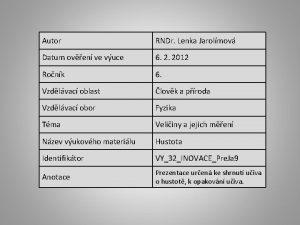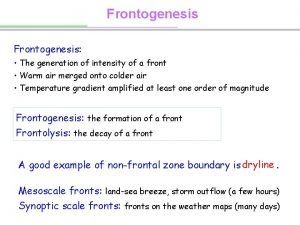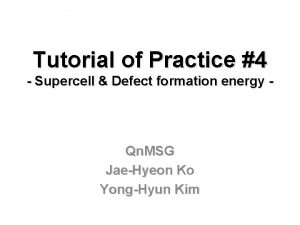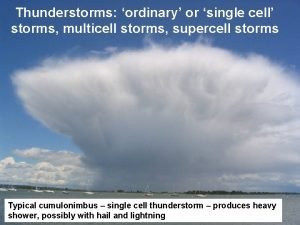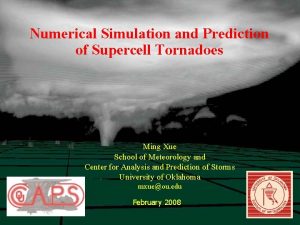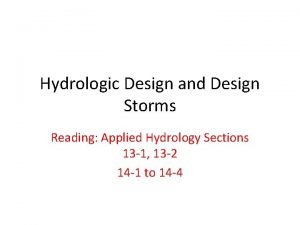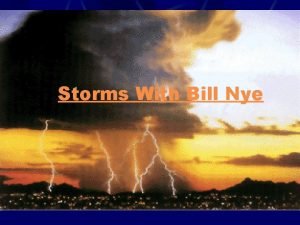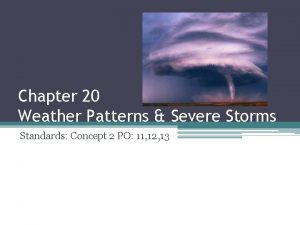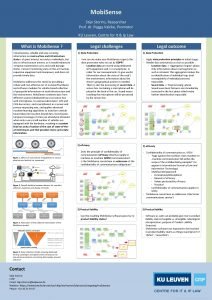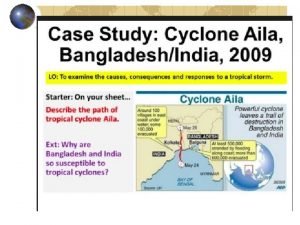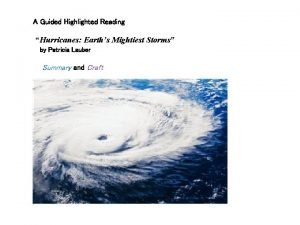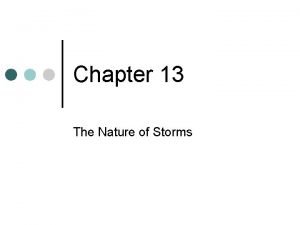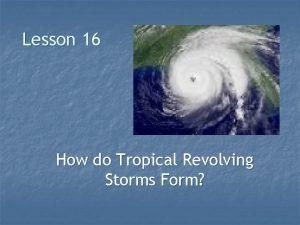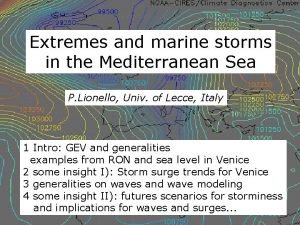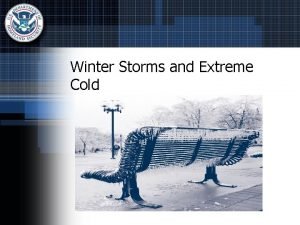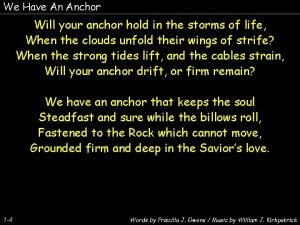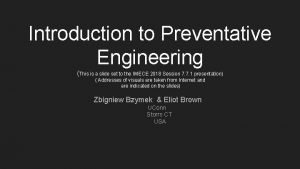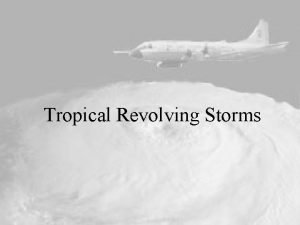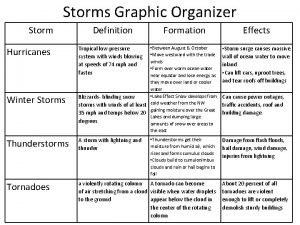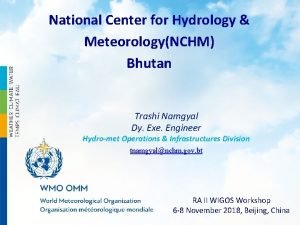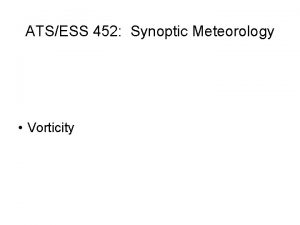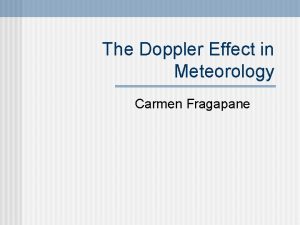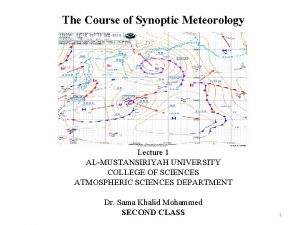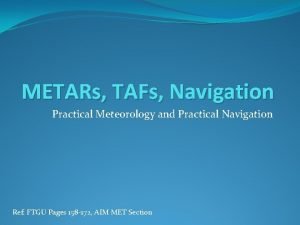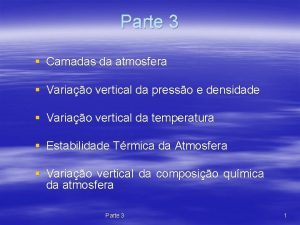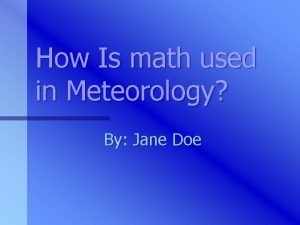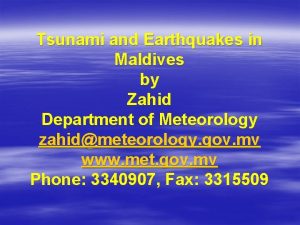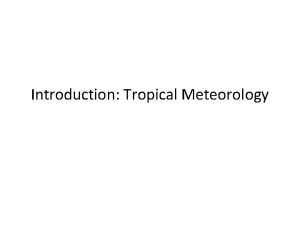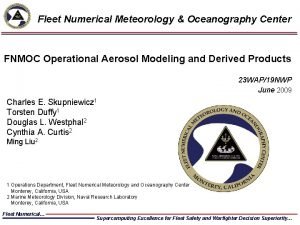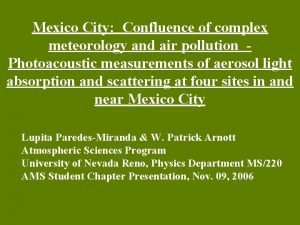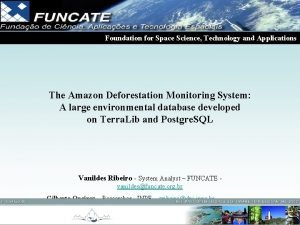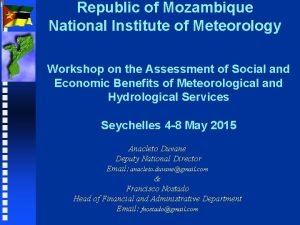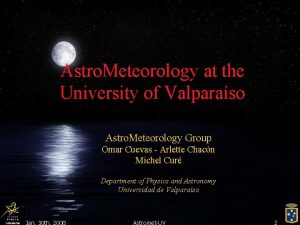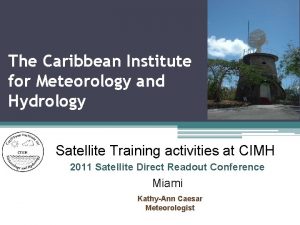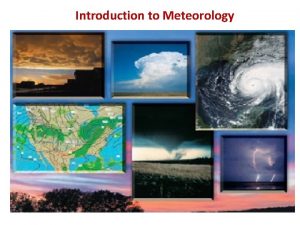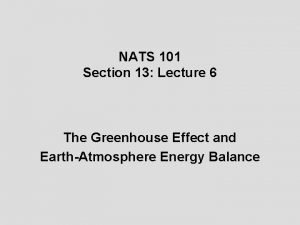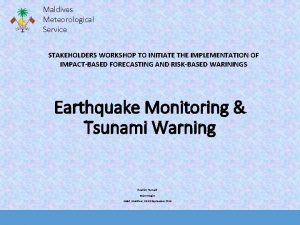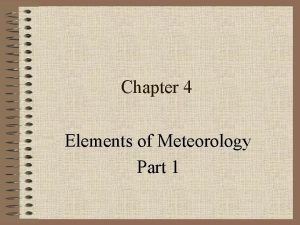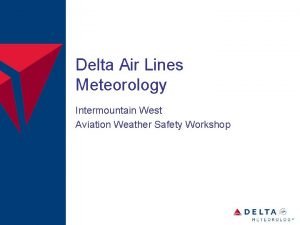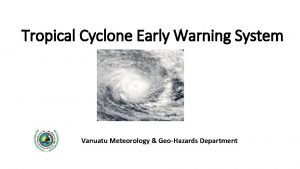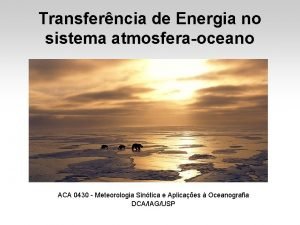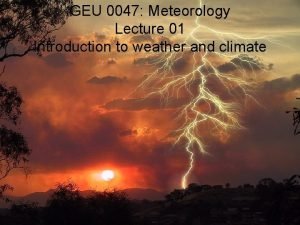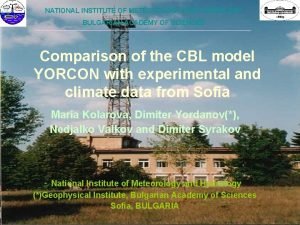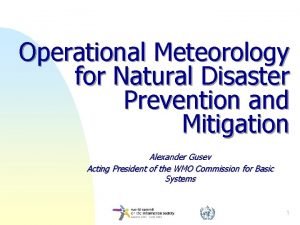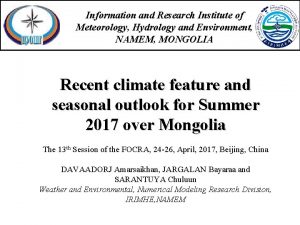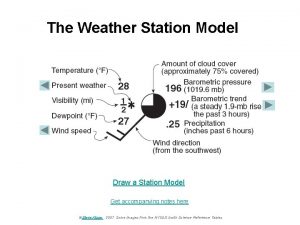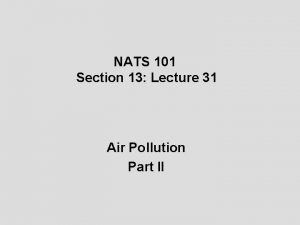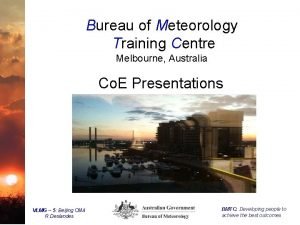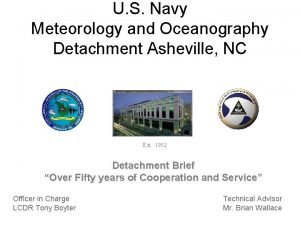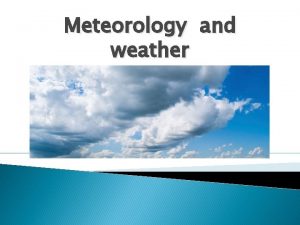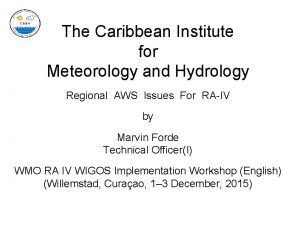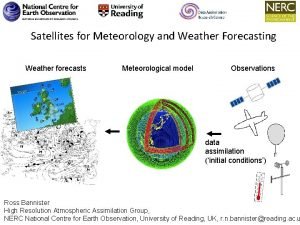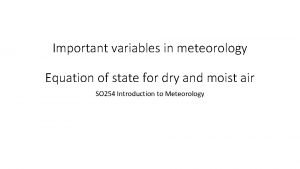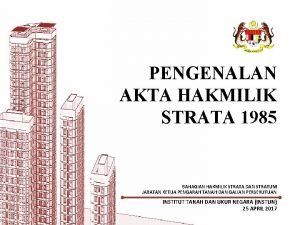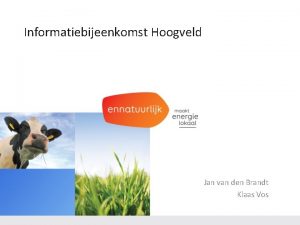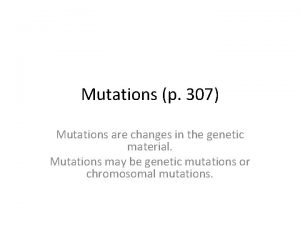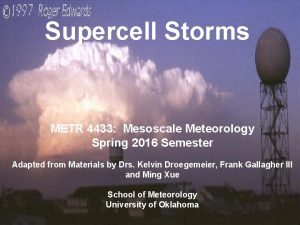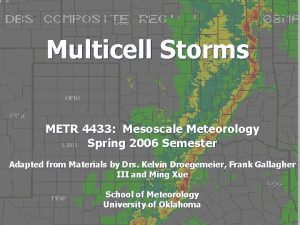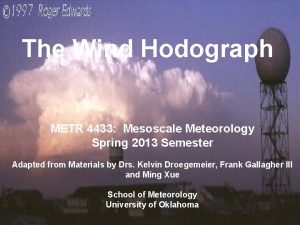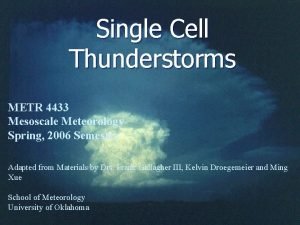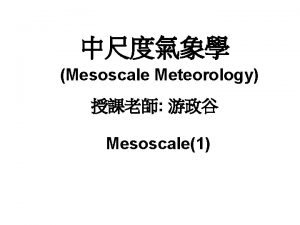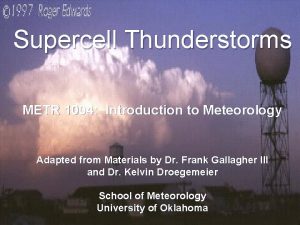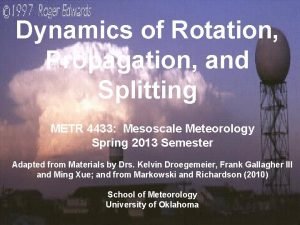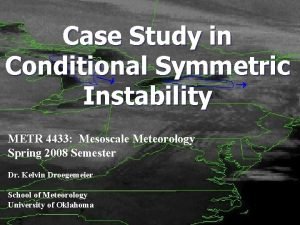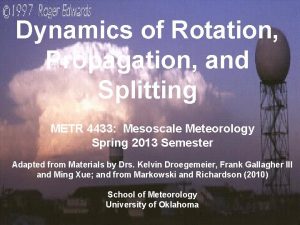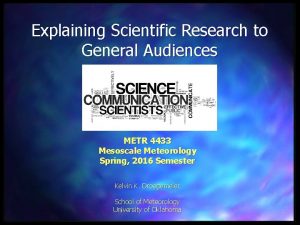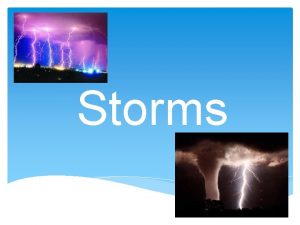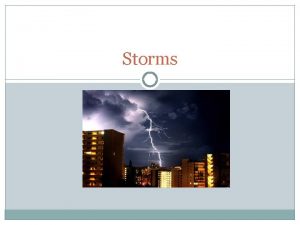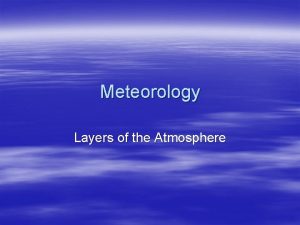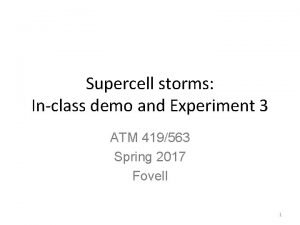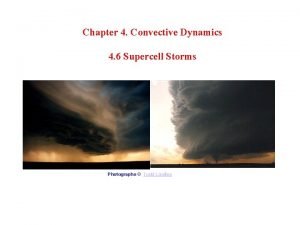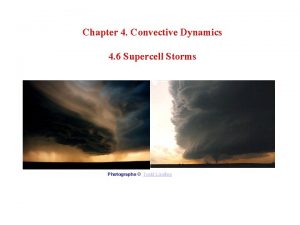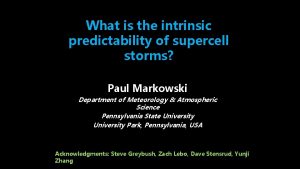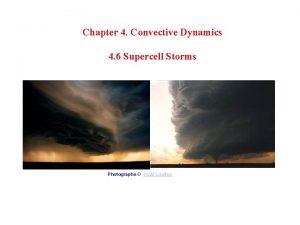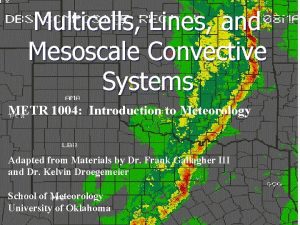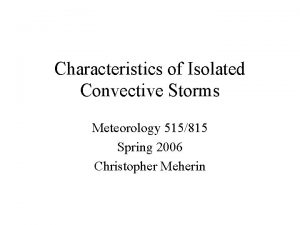Supercell Storms METR 4433 Mesoscale Meteorology Spring 2016






























































































































- Slides: 126

Supercell Storms METR 4433: Mesoscale Meteorology Spring 2016 Semester Adapted from Materials by Drs. Kelvin Droegemeier, Frank Gallagher III and Ming Xue School of Meteorology University of Oklahoma 1

2

3

Supercell Thunderstorms n n A very large storm with one principal updraft Quasi-steady in physical structure – Continuous updraft – Continuous downdraft – Persistent updraft/downdraft couplet n n n Rotating Updraft --- Mesocyclone Lifetime of several hours Highly three-dimensional in structure 4

Supercell Thunderstorms Potentially the most dangerous of all the convective types of storms n Potpourri of severe and dangerous weather n – High winds – Large and damaging hail – Frequent lightning – Large and long-lived tornadoes 5

Supercell Thunderstorms n Form in an environment of strong winds and high shear – Provides a mechanism for separating the updraft and downdraft 6

7

Upd aft ndr Dow raft Structure of a Supercell Storm 8

9

Schematic Diagram of a Supercell Storm (C. Doswell) 10

11

12

Structure of a Supercell Storm Mesocyclone 13

Supercell Structure Forward Flank Downdraft Tornado Rear Flank Downdraft Flanking Line/ Gust Front Mesocyclone Gustnado Inflow © 1993 Oxford University Press -- From: Bluestein, Synoptic-Dynamic Meteorology -- Volume II: Observations and Theory of Weather Systems 14

Perturbation Pressure Field Hydrostatic High In Cold Pool Inflow Low 15

3 D Flow in a supercell 16

Animation of a Numerically Simulated Supercell Storm n https: //www. youtube. com/watch? v=Egu m. U 0 Ns 1 YI R. Wilhelmson, University of Illinois at Urbana-Champaign 17

A Supercell on NEXRAD Doppler Radar Hook Echo 18

A Supercell on NEXRAD Doppler Radar Hook Echo 19

Where is the Supercell? 20

Where is the Supercell? 21

Supercell Types Classic n Low-precipitation n High-precipitation n 22

Low Precipitation (LP) Supercells Little or no visible precipitation n Clearly show rotation n Cloud base is easily seen and is often small in diameter n Radar may not indicate rotation in the storm although they may have a persistent rotation n LP storms are frequently non-tornadic n LP storms are frequently non-severe n 23

LP Supercell Side View Schematic © 1993 American Geophysical Union -- From: Church et al. , The Tornado 24

LP Supercell Top View Schematic © 1993 American Geophysical Union -- From: Church et al. , The Tornado 25

LP Supercell © 1995 Robert Prentice 26

LP Supercell © 1995 Robert Prentice 27

Another LP Supercell © 1993 Oxford University Press -- From: Bluestein, Synoptic-Dynamic Meteorology -- Volume II: Observations and Theory of Weather Systems 28

A Tornadic LP Supercell 26 May 1994 -- Texas Panhandle 29 © 1998 Prentice-Hall, Inc. -- From: Lutgens and Tarbuck, The Atmosphere, 7 th Ed.

High Precipitation (HP) Supercells n n n Substantial precipitation in mesocyclone May have a recognizable hook echo on radar (many do not, however) Reflectivities in the hook are comperable to those in the core Most common form of supercell May produce torrential, flood-producing rain Visible sign of rotation may be difficult to detect -- Easily detected by radar 30

HP Supercells © 1993 American Geophysical Union -- From: Church et al. , The Tornado 31

HP Supercells © 1993 American Geophysical Union -- From: Church et al. , The Tornado 32

HP Supercell Heaviest Precipitation (core) Kansas Woods County, Oklahoma 4 OCT 1998 2120 UTC KTLX 33

Twenty minutes later …. . Heaviest Precipitation (core) Kansas Oklahoma HP Supercell 4 OCT 1998 2150 UTC KTLX Developing Cells 34

Classic Supercells Traditional conceptual model of supercells n Usually some precipitation but not usually torrential n n n Reflectivities in the hook are usually less than those in the core Rotation is usually seen both visually and on radar 35

Classic Supercells © 1993 American Geophysical Union -- From: Church et al. , The Tornado 36

Classic Supercells © 1993 American Geophysical Union -- From: Church et al. , The Tornado 37

Classic Supercell Heaviest Precipitation (core) Hook 38

Hybrids Class distinctions are much less obvious in the real world! n Visibly a storm may look different on radar than it does in person -- makes storms difficult to classify n Supercells often evolve from LP Classic HP. There is a continuous spectrum of storm types. n 39

Supercell Evolution -- Early Phase Side View Top View Heaviest Precipitation © 1993 Oxford University Press -- From: Bluestein, Synoptic-Dynamic Meteorology -- Volume II: Observations and Theory of Weather Systems 40

Supercell Evolution n Early Phase – Initial cell development is essentially identical to that of a short-lived single cell storm. – Radar reflectivity is vertically stacked – Motion of the storm is generally in the direction of the mean wind – Storm shape is circular (from above) and symmetrical – Key ingredients » Conditional instability » Source of lift and vertical motion » Warm, moist air 41

Supercell Evolution -- Middle Phase Side View Top View Heaviest Precipitation © 1993 Oxford University Press -- From: Bluestein, Synoptic-Dynamic Meteorology -- Volume II: Observations and Theory of Weather Systems 42

Supercell Evolution n Middle Phase – As the storm develops, the strong wind shear alters the storm characteristics from that of a single cell – The reflectivity pattern is elongated down wind -- the stronger winds aloft blow the precipitation – The strongest reflectivity gradient is usually along the SW corner of the storm – Instead of being vertical, the updraft and downdraft become separated 43

Supercell Evolution n Middle Phase – After about an hour, the radar pattern indicates a “weak echo region” (WER) – This tells us that the updraft is strong and scours out precipitation from the updraft – Precipitation aloft “overhangs” a rain free region at the bottom of the storm. – The storm starts to turn to the right of the mean wind into the supply of warm, moist air 44

Supercell Evolution -- Mature Phase Side View Top View Hook Heaviest Precipitation © 1993 Oxford University Press -- From: Bluestein, Synoptic-Dynamic Meteorology -- Volume II: Observations and Theory of Weather Systems 45

Supercell Evolution n Mature Phase – After about 90 minutes, the storm has reached a quasi-steady mature phase – Rotation is now evident and a mesocyclone (the rotating updraft) has started – This rotation (usually CCW) creates a hook -like appendage on the southwest flank of the storm 46

Supercell Evolution -- Mature Phase Hook Echo 47

Supercell Evolution n Mature Phase – The updraft increases in strength and more precipitation, including hail, is held aloft and scoured out of the updraft – As the storm produces more precipitation, the weak echo region, at some midlevels, becomes “bounded” – This bounded weak echo region (BWER), or “vault, ” resembles (on radar) a hole of no precipitation surrounded by a ring of precipitation 48

Supercell Evolution -- Mature Phase Slice 4 km Bounded Weak Echo Region © 1990 *Aster Press -- From: Cotton, Storms 49

Splitting Storms If the shear is favorable, both circulations may continue to exist. n In this case the storm will split into two new storms. n We will look at this in greater detail later. n 50

Splitting Storms © 1990 *Aster Press -- From: Cotton, Storms 51

Movie of Splitting Courtesy NCAR 52

Splitting Storms Left Mover Split Right Mover © 1993 Oxford University Press -- From: Bluestein, Synoptic-Dynamic Meteorology -- Volume II: Observations and Theory of Weather Systems 53

Updraft The updraft is the rising column of air in the supercell n It generally is located on the front or right side of the storm n Entrainment is small in the core of the updraft n Updraft speeds may reach 50 m s-1!!! n Radar indicates that the strongest updrafts occur in the middle and upper parts of the storm n 54

Updraft n Factors affecting the updraft speed – Vertical pressure gradients » Small effect but locally important » Regions of local convergence can result in local areas of increased pressure gradients – Turbulence – Buoyancy » The more unstable the air, the larger the buoyancy of the parcel as they rise in the atmosphere » The larger the temperature difference between the parcel and the environment, the greater the buoyancy and the faster the updraft 55

Structure of a Supercell Storm Meso. Cyclone 56

57

Mesocyclone A cyclonic vortex marking the updraft of a supercell storm n Usually 2 -10 km in diameter n Vertically coherent for a few km, sometimes extending throughout a significant depth of the storm n Vertical vorticity on the order of 10 -2 s-1 n Visually manifest as the wall cloud n Different mechanisms for mid-level and low-level formation n 58

The Wall Cloud Meso. Cyclone 59

The Wall Cloud Meso. Cyclone 60

Wall Cloud n n Cyclonic rotation and strong rising motion often are visible within the wall cloud The squared-off lowering results from low pressure inside of the rotating updraft: as air approaches the vortex laterally, toward, it condenses – just like air that rises vertically toward lower pressure condenses to form clouds L 61

The Wall Cloud 62

The Wall Cloud 63

The Wall Cloud 64

3 D Storm Simulation Courtesy Lou Wicker, NSSL http: //kkd. ou. edu/METR_4803_Spring_2005/Wicker_Movie. mov 65

Some Storms Produce Mesocyclone Families: Cyclic Mesocyclogenesis Burgess et al. 1982 66

Cyclic Mesocyclogenesis: Conceptual Model from Numerical Simulation Adlerman, Droegemeier, and Davies-Jones 1999 67

Cyclic Mesocyclogenesis: Conceptual Model from Numerical Simulation & Adlerman, Droegemeier, and Davies-Jones 1999 68

Comparison With Observations Computer Simulation Mobile Doppler Radar Courtesy J. Wurman 69

Supercell Downdrafts n The same forces that affect updrafts also help to initiate, maintain, or dissipate downdrafts: – Vertical PGF – Buoyancy (including precipitation loading) – Turbulence n Downdraft wind speeds may exceed 40 m s-1 70

Supercell Downdrafts n We shall examine two distinct downdrafts associated with supercell thunderstorms: – Forward Flank Downdraft (FFD) – Rear Flank Downdraft (RFD) 71

Forward Flank Downdraft Associated with the heavy precipitation core of supercells. n Air in the downdraft originates within the column of precipitation as well as below the cloud base where evaporational cooling is important. n Forms in the forward flank (with respect to storm motion) of the storm. n FFD air spreads out when it hits the ground and forms a gust front. n 72

Rear Flank Downdraft Forms at the rear, or upshear, side of the storm. n Result of the storm “blocking” the flow of ambient air. n Maintained and enhanced by the evaporation of anvil precipitation. n Enhanced by mid-level dry air entrainment and associated evaporational cooling. n Located adjacent to the updraft. n 73

Supercell Downdrafts Forward Flank Downdraft Rear Flank Downdraft Inflow © 1993 Oxford University Press -- From: Bluestein, Synoptic-Dynamic Meteorology -- Volume II: Observations and Theory of Weather Systems 74

Rear Flank Downdraft Forms at the rear, or upshear, side of the storm. n Result of the storm “blocking” the flow of ambient air. n Maintained and enhanced by the evaporation of anvil precipitation. n Enhanced by mid-level dry air entrainment and associated evaporational cooling. n Located adjacent to the updraft. n 75

Supercell Downdrafts Forward Flank Downdraft Rear Flank Downdraft Inflow © 1993 Oxford University Press -- From: Bluestein, Synoptic-Dynamic Meteorology -- Volume II: Observations and Theory of Weather Systems 76

Formation of the RFD n Imagine a river flowing straight in a smooth channel. The water down the center flows smoothly at essentially a constant speed. n The pressure down the center of the channel is constant along the channel. n 77

Formation of the RFD n Let us now place a large rock in the center of the channel. The water must flow around the rock. n A region of high pressure forms at the front edge of the rock -- Here the water moves slowly -- Stagnation Point n 78

Formation of the RFD This happens in the atmosphere also! n The updraft acts a an obstruction to the upper level flow. n 79

Formation of the RFD The RFD descends, with the help of evaporatively cooled air, to the ground. n When it hits the ground, it forms a gust front. n Upper-level Flow Updraft RFD FFD Mid-level Flow Gust Front Inflow 80

Supercell Updraft Rotation In order for supercells to rotate, there must be some type of rotation already available in the environment. n We shall consider several different ways of creating vertical vorticity or rotation about a vertical axis: n 81

Vorticity Dynamics Must consider 3 D equations of motion n Can neglect Coriolis force n Vector Form or or 82

Vorticity Dynamics or 83

Vorticity Dynamics n Recall the definition of vorticity as the curl of the 3 D velocity vector (del x V): 84

Vorticity Dynamics n Taking del x momentum equation gives 85

Vorticity Dynamics 0 86

Vorticity Dynamics n Rearranging gives 87

Vorticity Dynamics n Rearranging gives 88

Vorticity Dynamics n Tilting term can be written 89

Vertical Wind Shear Up Westerly Winds Increase in Speed with height North East 90

Vorticity Dynamics n Tilting term can be written 0 91

Vertical Wind Shear Up Westerly Winds Increase in Speed with height North East 92

Development of Mid-Level Rotation Up North East 93

Tilting n In order to create vertical rotation from horizontal rotation, we must tilt the horizontal rotation into the vertical. 94

Tilting n In thunderstorms, this tilting is achieved by the updraft. Updraft 95

Development of Mid-Level Rotation + or Cyclonic Thunderstorm Up - or Anti-Cyclonic North East 96

Tilting n Viewed from above, we see a pair of counter-rotating vortices: “Positive Rotation” “Negative Rotation” 97

Tilting Vortex Tube Updraft Play Movie © 1990 *Aster Press -- From: Cotton, Storms 98

Development of Mid-Level Rotation n In this simple example, the updraft has no NET rotation because the vortex pair straddles the updraft +w>0 n In most supercells, the updraft is dominantly cyclonic. Why? The answer lies in the STORM-RELATIVE winds. 99

Storm-Relative Winds Absolute velocity = Relative Velocity + Velocity of Coordinate System 40 mph 100

Storm-Relative Winds Absolute velocity = Relative Velocity + Velocity of Coordinate System 90 mph 40 mph 101

Storm-Relative Winds Absolute velocity = Relative Velocity + Velocity of Coordinate System 90 mph 130 mph 40 mph 102

Storm-Relative Winds Absolute velocity = Relative Velocity + Velocity of Coordinate System Relative Velocity = 90 mph Absolute Velocity = 130 mph Velocity of Coordinate System= 40 mph 103

Storm-Relative Winds Absolute velocity = Relative Velocity + Velocity of Coordinate System Environmental Wind = Storm-Relative Winds + Storm Motion Storm-Relative Winds = Environmental Wind – Storm Motion = 30 mph Environ = 20 mph Storm-Relative = -10 mph 104

Storm-Relative Winds = Environmental Wind – Storm Motion = 20 mph Environ = 40 mph Storm-Relative = 20 mph 105

Storm-Relative Winds = Environmental Wind – Storm Motion = 20 mph Environ = 40 mph Storm-Relative = -60 mph 106

The Only Thing that EVER Matters is the Storm-Relative Wind 107

Importance of Storm-Relative Winds Want to intensify the cyclonic vortex on the south side Vortex Tube Updraft Play Movie © 1990 *Aster Press -- From: Cotton, Storms 108

Importance of Storm-Relative Winds Want to intensify the cyclonic vortex on the south side Vortex Tube Updraft Storm-Relative Winds Play Movie © 1990 *Aster Press -- From: Cotton, Storms 109

Importance of Storm-Relative Winds Vortex Tube Updraft Play Movie © 1990 *Aster Press -- From: Cotton, Storms 110

Importance of Storm-Relative Winds Vortex Tube Storm-Relative Winds Updraft Play Movie © 1990 *Aster Press -- From: Cotton, Storms 111

Importance of Storm-Relative Winds Vortex Tube Storm-Relative Winds Updraft Play Movie © 1990 *Aster Press -- From: Cotton, Storms 112

Importance of Storm-Relative Winds We obtain strong updraft rotation if the storm-relative winds are parallel to the horizontal vorticity – or perpendicular to the environmental shear vector Vortex Tube Storm-Relative Winds Updraft Play Movie © 1990 *Aster Press -- From: Cotton, Storms 113

Vertical Wind Shear Up Westerly Winds Increase in Speed with height North East 114

Vertical Wind Shear Up Shear = V(upper) – V(lower) North East 115

Vertical Wind Shear Up Shear = V(upper) – V(lower) North East 116

Vertical Wind Shear Up Shear = V(upper) – V(lower) Shear Vector East 117

Development of Mid-Level Rotation Up Note that the vorticity vector points 90 deg to the left of the shear vector North Shear Vector East 118

Importance of Storm-Relative Winds We obtain strong updraft rotation if the storm-relative winds are parallel to the horizontal vorticity – or perpendicular to the environmental shear vector – because this leads to immediate vortex stretching of the updraft Shear Vector Vorticity Vector Storm-Relative Winds Play Movie © 1990 *Aster Press -- From: Cotton, Storms 119

Stretching (Convergence) Term Becomes 120

Development of Mid-Level Rotation Updraft - Stretch Up North East 121

Development of Low-Level Updraft Rotation Cannot be explained by stretching at mid-levels alone because of w=0 condition at ground n Clear sequence of events precedes rapid spin-up of vorticity at low levels: n – Decrease in updraft intensity – Rear-flank downdraft (RFD) – Cold outflow 122

Supercell Structure Forward Flank Downdraft Tornado Rear Flank Downdraft Flanking Line/ Gust Front Mesocyclone Gustnado Inflow © 1993 Oxford University Press -- From: Bluestein, Synoptic-Dynamic Meteorology -- Volume II: Observations and Theory of Weather Systems 123

Recall Horizontal Vorticity Generation Along Temperature Gradients n Air travelling along a frontal zone will develop a horizontal rotation. 124

Role of Forward Flank Downdraft n n Air flowing along the cold boundary of the FFD enters the mesocyclone This horizontal vorticity is tilted at very low levels and stretched 125

3 -D Depiction From Klemp (1987) 126
 Kilo železa
Kilo železa Mesoscale definition
Mesoscale definition Skládací metr wikipedia
Skládací metr wikipedia Krejčovský metr dm
Krejčovský metr dm Aplikace metr
Aplikace metr Metr decymetr to jednostki
Metr decymetr to jednostki Frontogenesis and frontolysis
Frontogenesis and frontolysis Supercell tutorial
Supercell tutorial Parts of a supercell thunderstorm
Parts of a supercell thunderstorm Supercell storm
Supercell storm Four seasons korean movie
Four seasons korean movie Fall months
Fall months Chapter 20 weather patterns and severe storms
Chapter 20 weather patterns and severe storms Design storms
Design storms Bill nye tornadoes
Bill nye tornadoes Chapter 20 weather patterns and severe storms
Chapter 20 weather patterns and severe storms Stijn storms
Stijn storms Stijn storms
Stijn storms Describe the global distribution of tropical storms
Describe the global distribution of tropical storms Hurricanes earth's mightiest storms
Hurricanes earth's mightiest storms Jo storms
Jo storms Chapter 13 the nature of storms
Chapter 13 the nature of storms How do tropical storms form
How do tropical storms form Freddy druif
Freddy druif Storms in the mediterranean sea
Storms in the mediterranean sea Aten symbol
Aten symbol Facts about winter storms
Facts about winter storms Will your anchor hold in the storms of life
Will your anchor hold in the storms of life Hurricanes tropical storms
Hurricanes tropical storms Egyptian god of storms
Egyptian god of storms Mark storms
Mark storms Easterly wave
Easterly wave Tornado graphic organizer
Tornado graphic organizer Meteorology 101
Meteorology 101 Cisk meteorology
Cisk meteorology National center for hydrology and meteorology
National center for hydrology and meteorology What is vorticity in meteorology
What is vorticity in meteorology Doppler effect meteorology
Doppler effect meteorology Synoptic meteorology definition
Synoptic meteorology definition How to read metar remarks
How to read metar remarks Introduction to tropical meteorology
Introduction to tropical meteorology Altura atmosfera
Altura atmosfera Math in meteorology
Math in meteorology Maldives earthquake
Maldives earthquake Introduction to tropical meteorology
Introduction to tropical meteorology Cin meteorology
Cin meteorology Fleet numerical meteorology and oceanography center
Fleet numerical meteorology and oceanography center Confluence meteorology
Confluence meteorology Anders persson meteorology
Anders persson meteorology Mozambique national institute of meteorology
Mozambique national institute of meteorology Astro meteorology
Astro meteorology Caribbean institute for meteorology and hydrology
Caribbean institute for meteorology and hydrology What does the diagram illustrate about turbidity currents?
What does the diagram illustrate about turbidity currents? Mesopause definition
Mesopause definition Meteorology today
Meteorology today Department of meteorology maldives
Department of meteorology maldives Elements of meteorology
Elements of meteorology Weather station model practice
Weather station model practice Delta meteorology
Delta meteorology N1bcurr.jpg
N1bcurr.jpg Vanuatu meteo cyclone warning
Vanuatu meteo cyclone warning Penn state meteorology
Penn state meteorology Onda eletromagnética
Onda eletromagnética Keeling curve
Keeling curve Yorcon
Yorcon Operational meteorology
Operational meteorology Meteorology hydrology and water management
Meteorology hydrology and water management How to draw a station model
How to draw a station model Meteorology today
Meteorology today Meteorology
Meteorology Types of visibility in meteorology
Types of visibility in meteorology Bureau of meteorology training centre
Bureau of meteorology training centre Us navy meteorology
Us navy meteorology The study of weather is
The study of weather is Caribbean institute for meteorology and hydrology
Caribbean institute for meteorology and hydrology Meteorology
Meteorology Suzanne gray
Suzanne gray Meted.ucar.edu
Meted.ucar.edu Latvian environment geology and meteorology centre
Latvian environment geology and meteorology centre Equation of state for dry air
Equation of state for dry air Konsep pembiayaan kesehatan
Konsep pembiayaan kesehatan Nouveauté windows server 2016
Nouveauté windows server 2016 2016/c 202/02
2016/c 202/02 Fut 2016
Fut 2016 Paraipaba - ceará 06 de julho de 2016. querido diário
Paraipaba - ceará 06 de julho de 2016. querido diário Fbc accessibility 2020
Fbc accessibility 2020 Microsoft excel 2016 basics vocabulary
Microsoft excel 2016 basics vocabulary Lukion opetussuunnitelma 2015
Lukion opetussuunnitelma 2015 Miinimumpalk bruto 2016
Miinimumpalk bruto 2016 Microsoft threat modeling tool
Microsoft threat modeling tool Standard toolbar in ms word 2013
Standard toolbar in ms word 2013 Exchange 2016 preferred architecture
Exchange 2016 preferred architecture Kotler p. armstrong g. principles of marketing
Kotler p. armstrong g. principles of marketing 2016 tni standard checklist
2016 tni standard checklist Ms word latest version
Ms word latest version Resolução cfmv nº 1138 de 16/12/2016
Resolução cfmv nº 1138 de 16/12/2016 Wpc2016 live dashboard
Wpc2016 live dashboard Microsoft official academic course microsoft word 2016
Microsoft official academic course microsoft word 2016 New zealand holiday 2016
New zealand holiday 2016 Akta hakmilik strata 1985
Akta hakmilik strata 1985 1 januari 2016
1 januari 2016 Mcrlab
Mcrlab Deped order no. 39 s. 2016
Deped order no. 39 s. 2016 Nou 2016:7
Nou 2016:7 Saasta astro quiz 2021 questions and answers
Saasta astro quiz 2021 questions and answers Acpe standards 2016
Acpe standards 2016 Zpg biologie 2016
Zpg biologie 2016 The national patient safety goal 6
The national patient safety goal 6 Terremoto assisi 2016
Terremoto assisi 2016 Pat data analysis
Pat data analysis Tni standards
Tni standards 2016 pearson education inc
2016 pearson education inc Weerwoordlessen
Weerwoordlessen Exploring microsoft office excel 2016 comprehensive
Exploring microsoft office excel 2016 comprehensive Year 6 sats 2016
Year 6 sats 2016 Ennatuurlijk
Ennatuurlijk Enem ppl 2016 para reciclar um motor
Enem ppl 2016 para reciclar um motor Forrester wave privileged identity management 2016
Forrester wave privileged identity management 2016 New zealand health strategy 2016
New zealand health strategy 2016 Deshabilitar vista protegida office 2016
Deshabilitar vista protegida office 2016 Oracle69 portfolio
Oracle69 portfolio Inhaltsbezogene kompetenzen deutsch
Inhaltsbezogene kompetenzen deutsch Multa artículo 177 numeral 5 gradualidad
Multa artículo 177 numeral 5 gradualidad Parker et al 2016
Parker et al 2016 P 307 2016
P 307 2016 Cacrep standards 2016
Cacrep standards 2016 Andmesisestaja tööpakkumine 2016
Andmesisestaja tööpakkumine 2016
